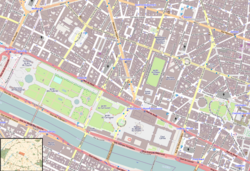Saint-Louis-du-Louvre
| Saint Louis of the Louvre | |
|---|---|
| L’église collégiale et paroissiale Saint-Louis-du-Louvre | |

Etienne Bouhot, The Entrance to the Musee de Louvre and St. Louis Church (1822)
|
|
| 48°51′37.6″N 2°20′6.0″E / 48.860444°N 2.335000°ECoordinates: 48°51′37.6″N 2°20′6.0″E / 48.860444°N 2.335000°E | |
| Location | Paris |
| Country | France |
| Denomination | Reformed Church of France (1791-1811) |
| Previous denomination | Roman Catholic (1187-1790) |
| History | |
| Former name(s) | L’église collégiale et paroissiale Saint-Thomas-du-Louvre |
| Authorising papal bull | 1199 |
| Founded | 1187 |
| Founder(s) | Robert I, Count of Dreux |
| Dedicated | 1744 (rededication) |
| Cult(s) present | Saint Thomas à Becket (1187-1744), Saint Louis (1744-1790) |
| Architecture | |
| Status | Collegiate church |
| Functional status | demolished |
| Architect(s) | Thomas Germain |
| Years built | 1739-1744 (rebuilt) |
| Construction cost | 50,000 Crowns |
| Demolished | 1811 |
| Administration | |
| Archdiocese | Paris |
Saint-Louis-du-Louvre, formerly Saint-Thomas-du-Louvre, was a medieval church in the 1st arrondissement of Paris located just west of the original Louvre Palace. It was founded as Saint-Thomas-du-Louvre in 1187 by Robert of Dreux as a Collegiate church. It had fallen into ruin by 1739 and was rebuilt as Saint-Louis-du-Louvre in 1744. The church was suppressed in 1790 during the French Revolution and turned over the next year for use as the first building dedicated to Protestant worship in the history of Paris, a role in which it continued until its demolition in 1811 to make way for Napoleon's expansion of the Louvre. The Reformed congregation was given l'Oratoire du Louvre as a replacement and saved the choir stalls from Saint-Louis-du-Louvre which are still in place at l'Oratoire.
On 8 October 1164, Thomas à Becket, the Archbishop of Canterbury, after intensifying conflict with Henry II over his efforts to reduce the power of the church through the Constitutions of Clarendon, was put on trial and convicted of various offenses by Henry in Northampton Castle. Becket proceeded to flee to France where he was welcomed and hosted for six years by Louis VII. Shortly after his return to England in 1170, Becket was famously murdered in Canterbury Cathedral and subsequently canonized in 1173. In 1179, Louis VII travelled to Canterbury to pay his respects to the saint, making a donation of a gold chalice and an annual donation of 100 muids (~3,400 gallons) of wine for the celebration of the annual feast.
...
Wikipedia

